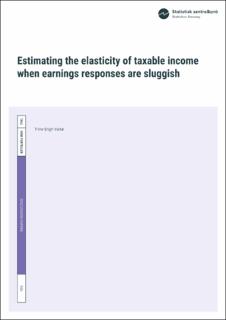| dc.contributor.author | Vattø, Trine Engh | |
| dc.date.accessioned | 2020-04-21T10:17:50Z | |
| dc.date.available | 2020-04-21T10:17:50Z | |
| dc.date.issued | 2020-04 | |
| dc.identifier.issn | 1892-753X | |
| dc.identifier.uri | https://hdl.handle.net/11250/2651834 | |
| dc.description.abstract | Estimates of the elasticity of taxable income (ETI) is conventionally obtained by “stacking” three-year overlapping differences in the estimation. In effect, this means that the ETI estimate is an average of first-, second-, and third-year effects. The present paper draws attention to this implication and suggests that if there is gradual adjustment the analyst should rather estimate the ETI by a dynamic panel data model. When using Norwegian income tax return data for wage earners over a 14-year period (1995−2008) in the estimation, an ETI estimate of 0.15 is obtained from the dynamic specification, compared to 0.11 for the conventional approach. Importantly, the conventional approach fails to render a long-term elasticity estimate by increasing the time span of each difference. | en_US |
| dc.language.iso | eng | en_US |
| dc.publisher | Statistisk sentralbyrå | en_US |
| dc.relation.ispartofseries | Discussion Paper;No. 926 | |
| dc.rights | Attribution-NonCommercial-NoDerivatives 4.0 Internasjonal | * |
| dc.rights.uri | http://creativecommons.org/licenses/by-nc-nd/4.0/deed.no | * |
| dc.subject | Skattereformer | en_US |
| dc.subject | ETI | en_US |
| dc.subject | Elastisitet av skattepliktig inntekt | en_US |
| dc.subject | Elasticity of taxable income | en_US |
| dc.subject | Tax reform | en_US |
| dc.title | Estimating the elasticity of taxable income when earnings responses are sluggish | en_US |
| dc.type | Working paper | en_US |
| dc.subject.nsi | VDP::Social science: 200::Economics: 210::Economics: 212 | en_US |
| dc.source.pagenumber | 46 | en_US |

